Bayer R.G. Mechanical Wear Fundamentals and Testing, Revised and Expanded
Подождите немного. Документ загружается.

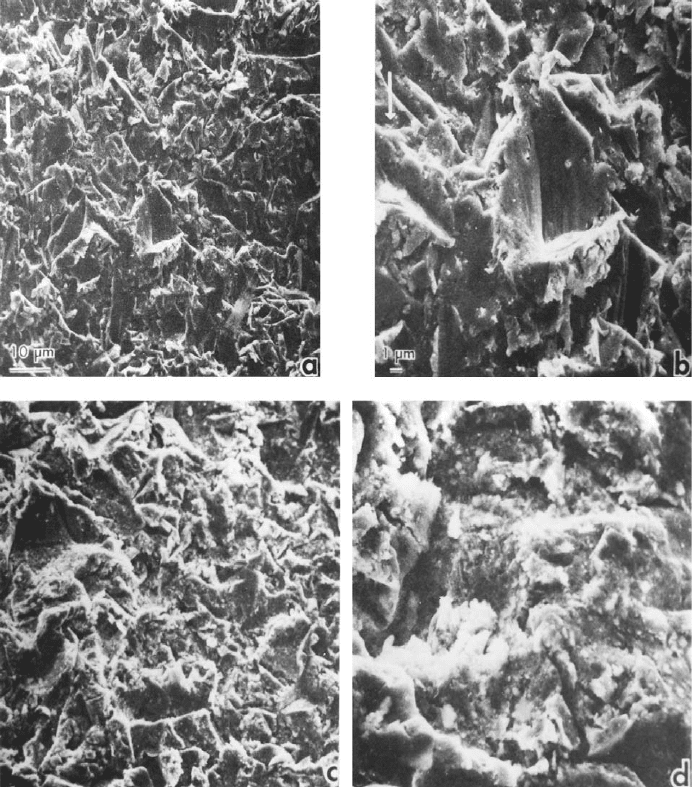
the test procedure calls for the testing of the reference material under those conditions that
are performed and reported.
Studies have been done to understand the effect of various parameters on the test
and to determine the level of control required. These studies also identified some of the
factors, which can influence this mode of wear (9). Among these are particle velocity,
abrasive or particle characteristics, particle flux, and temperature. Differences between
the test and application conditions with respect to these parameters cause the test to
provide a relative ranking rather than absolute performance. However, the erosion value
generated in this test does provide some means of directly relating test and application.
This is in term s of amount of abrasive. The erosion value is defined as wear per amount
of abrasive. Therefore, knowledge of the amount of abrasive experienced or the amount
Figure 9.13 Morphology of particle erosion wear scars for grazing- (‘‘A’’ and ‘‘B’’) and near-
normal (‘‘C’’ and ‘‘D’’) impact conditions. (From Ref. 115, reprinted with permission from ASTM.)
Copyright 2004 by Marcel Dekker, Inc. All Rights Reserved.
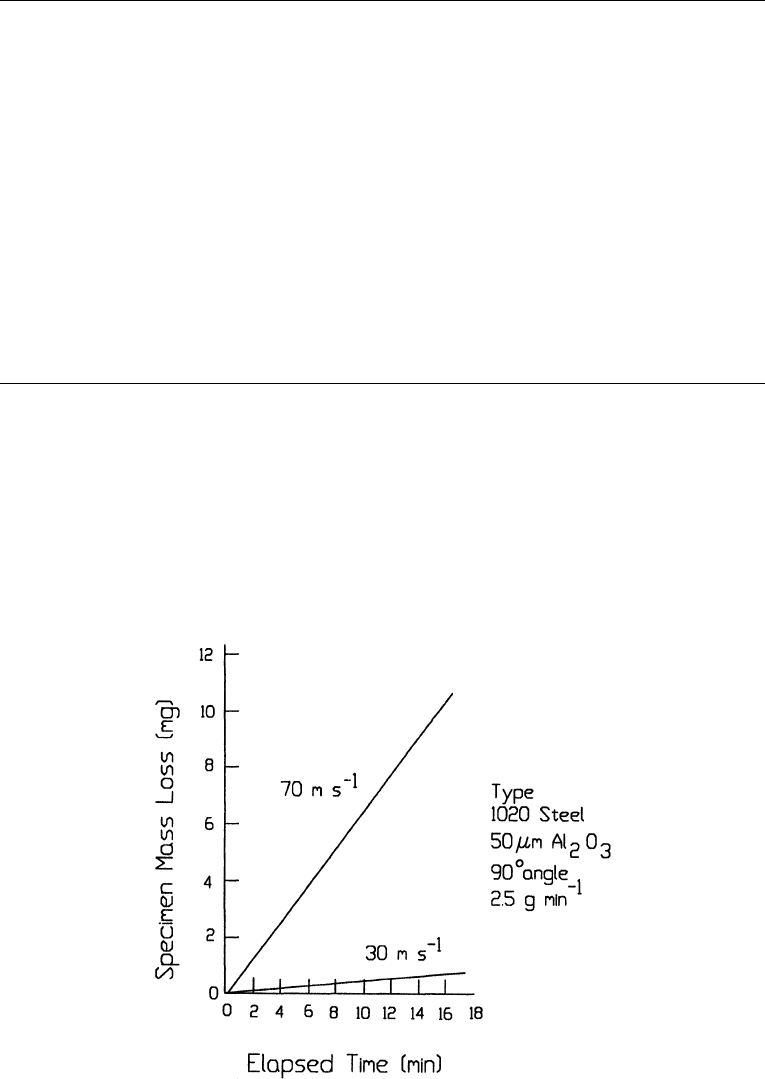
of abrasive per unit time in an application can provide an estimate of the wear or wear
rate in the application. This information can also aid in assessing the relative severity of
the test to the application and possible acceleration. Although additional aspects of
theparticlestreamsinthetwosituations
are also needed to address these elements
completely, such as type and velocity of the particles, and impingement angle.
In the standard tests methods for dry and wet sand and slurry abrasivity, the design
of the test apparatus is treated in more detai l than in the standard test method for this
Table 9.1 Standard Test Conditions of ASTM G76 Test Method for Solid Particle Erosion
Nozzle tube Dimensions ID 1.5 mm0.075 mm; minimum length 50 mm
Orientation Axis 90 2
with specimen surface
Position 10 1 mm from specimen surface
Test gas Dry air
Particle Composition Al
2
O
3
Size 50 mm
Shape Angular
Feed rate 2.0 0.5 g=min
Velocity 30 2m=sec
Flow Rate 8 L=min
Presssure 140 kPa (may be different)
Duration Minimum, 10 min; maximum, any acceptable
provided crater depth does not exceed 1 mm
Temperature 18–28
Figure 9.14 Wear curves obtained in the solid particle erosion test for 1020 steel at two different
velocities. (From Ref. 115.)
Copyright 2004 by Marcel Dekker, Inc. All Rights Reserved.
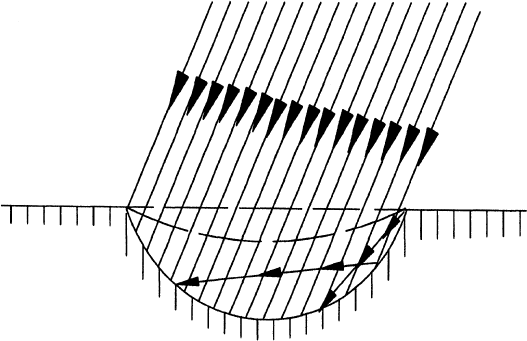
erosion test. This is because of the nature of the wear situation involved. In the former
two bodies pressed against one another under conditions of relative motion generate the
wear. In these types of situations the alignment, rigidity, and consistency of speed provi-
ded by structure have significant influence on wear behavior. Hence, there is a need to
control the structure to a high degree in those cases. In the present erosion test, however,
the situation is obviously quite diff erent. The pressing together of two bodies does not
provide the wearing action but rather by the impingement of gas stream. As a consequence,
alignment and characteristics of this stream are the controlling factors. Such items as the
static alignment of the nozzle with respect to the wear spe cimen, the nozzle shape,
particle flux, particle velocity, and other aspects of the stream are of importance. Since
these are recognized in the method and tolerances are specified, the design of the rest
of the apparatus is not critical.
This test also illustrates another aspect discussed in the general section on wear test-
ing, which is the need to develop unique methods to measure and control certain para-
meters. Examples of this in the gas jet test are the measurement techniques for abrasive
flux and abrasive particle velocity. These are both significant factors in the test and
required development. A method for the former is presented and references to techniques
developed for the latter are given in the ASTM standard, G76 (10–12).
9.2.5. Vibratory Cavitation Erosion Test
This test was developed to simulate the erosive wear caused by the formation and
collapse of cavitation bubbles in applications associated with high-speed hydrodynamic
systems. Surface s of hydraulic turbines, pumps, propellers, and hydrofoils are exposed to
this type of wear. This test has been used as a mechanism for studying cavitation erosion
and has been used successfully in the selec tion and ranking of materials for applications
wherethistypeofwearisofconcern.ThetestisillustratedinFig.9.17
. The cavitation
field generated at the surface of a vibrating specimen immersed in a liquid is used to
generate wear. The wear surface of the specimen, which is submerged, is located close
to the surface of the liquid, and an ultrasonic horn is used to vibrate the specimen.
Figure 9.15 An illustration of the effect of erosion wear scar geometry on particle impact condi-
tions. As a result of wear, the angles of impact are no longer constant across the surface.
Copyright 2004 by Marcel Dekker, Inc. All Rights Reserved.
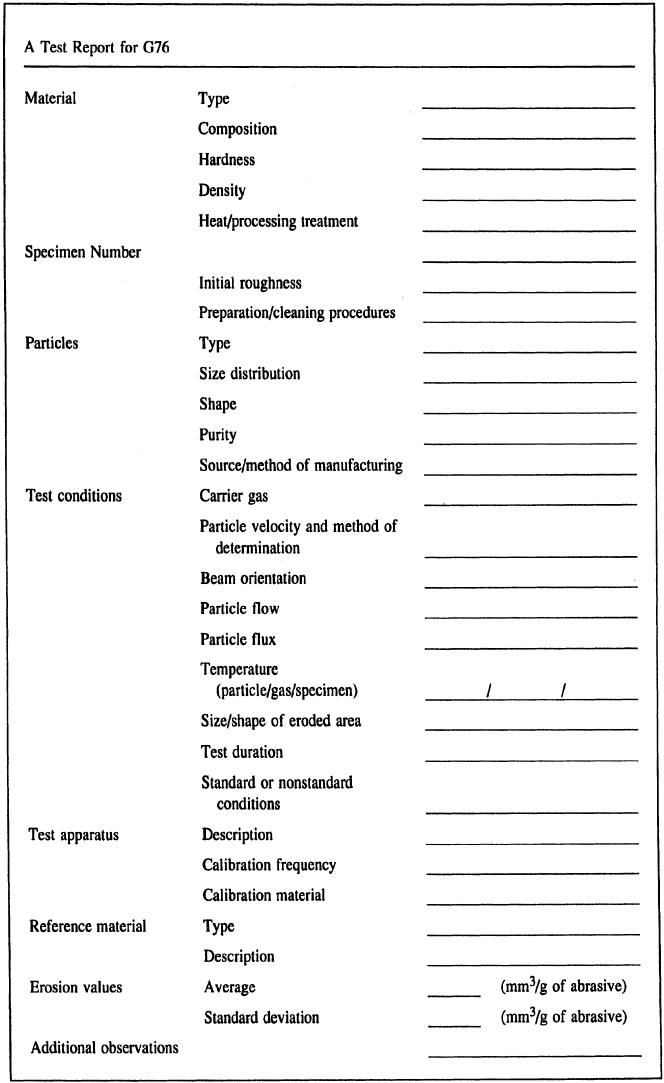
Figure 9.16 Data and information that are to be reported with the ASTM solid particle erosion
test.
Copyright 2004 by Marcel Dekker, Inc. All Rights Reserved.
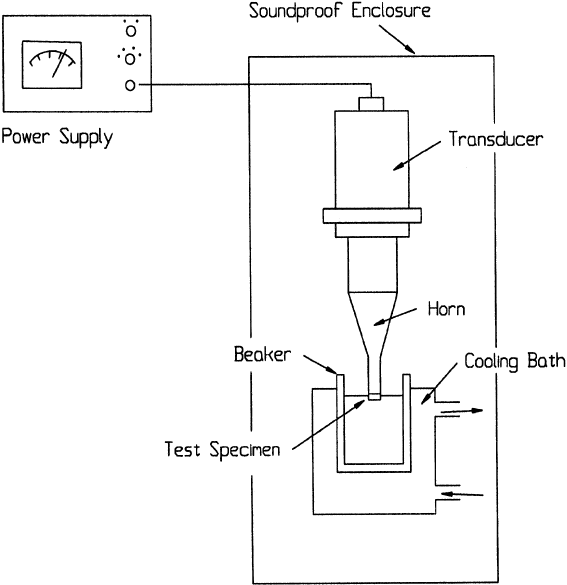
A standard method for conducting this test is described in ASTM G32. The results of
tests conducted with this procedure typically repeat within 20%.
Like the solid particle erosion test, the standard cavitation erosion test method
focuses on the control in the immediate wear situation and not the overall apparatus.
In addition to specimen geometry, other influences on cavitation include the temperature
and properties of the fluid, the frequency and amplitude of the vibration, and the pressure
above the liquid (13–21). Also, the method of specimen attachment can influence the cou-
pling of the ultrasonic vibration between the specimen and the horn and therefore effects
the cavitation. The standard method requires control of the frequency and amplitude of
the vibration, control of the specimen and the liquid, including its temperature, attachment
of the specimen to the vibrator, and pressure over the fluid. Procedures and techniques for
implementing the test are given, as well as cautions regarding some of the common pro-
blems encountered with this type of test. Along with wear data, the method also requires
the recording and reporting of additional information, including specimen characteriza-
tion, test parameters (if the recommended standard ones are not used), identification of
the liquid used, and observations of singular or unusual nature. The standard also specifies
that tests on a reference material or materials should be done in any test program a s a
means of control. If nonstandard conditions are use d, it provides a means of relating test
conditions. Several reference materials are identified in the standard for this purpose.
The wear produced in this test is directly measured as mass loss. By using the density
of the wear surface and the dimensions of the standard wear specimen, mass loss is
Figure 9.17 Schematic of the vibratory cavitation test apparatus.
Copyright 2004 by Marcel Dekker, Inc. All Rights Reserved.
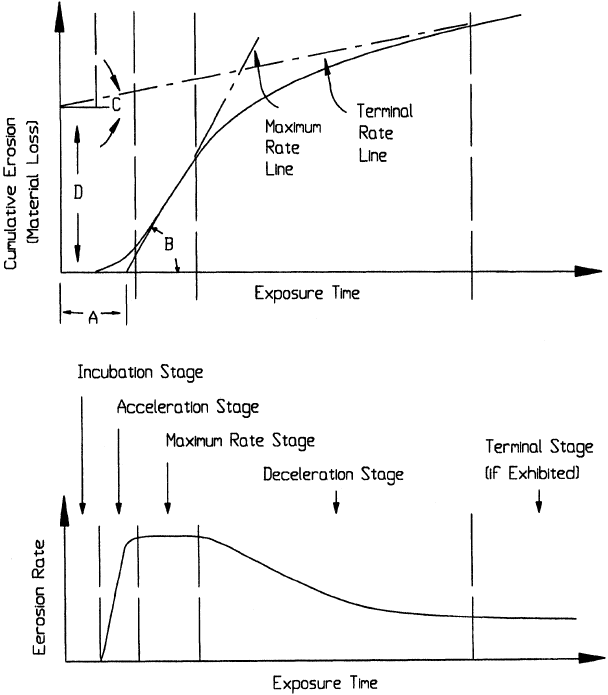
converted to a wear depth, which is used as the measure of wear performance. The stan-
dard method requires the reporting of the mass loss as well as the wear depth. The test
method involves the generation of a wear cu rve (i.e., wear depth vs. time) by interrupting
the test at appropriate intervals. Typical curves for wear and wear rate from this test are
showninFig.9.18
. While these curves are generally nonlinear, their shapes tend to vary.
Both the intervals and overall duration of the test are dependent on the materials being
evaluated and the test conditions. If possible, the duration should be long enough
so that a maximum wear rate is produced. If that is not possible, diff erent test times
should be used so that the materials compared reach the same depth of wear. The
intervals also should be selected so that a well-defined curve can be established. In
practice, this means that the test can range from a few to 10 or more hours.
In several of the preceding tests, a wear curve was developed and fitted to some
functional relationship. The best fit was then used to develop a single value that was used
to compare wear resistance or quantify wear behavior. In the slurry abrasion test, for
example, this was the wear rate after 2 hr. While it would be desirable to do something
Figure 9.18 The general forms of the wear curve and the curve for erosion rate as a function of test
time obtained in the vibratory cavitation erosion test. (From Ref. 117.)
Copyright 2004 by Marcel Dekker, Inc. All Rights Reserved.
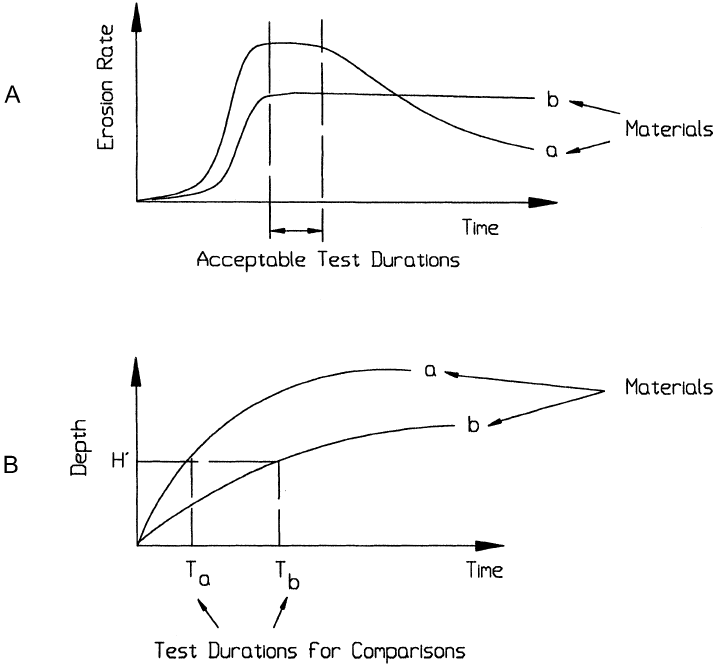
similar in the case of cavitation, there is no consistency of behavior be tween materials to
make such an ap proach generally feasible. While some mate rials exhibit a maximum ero-
sion or wear rate in the test, others do not. In addition, the shape of the wear curve
appears to be sensitive to the manner in which the test is conducted. This range of
behaviorcanbeseeninFig.9.19
. Thus, the standard requir es the reporting of the wear
curve itself and that material performance be compared in terms of the relationship of
one curve to the other. In any individual study, the wear curves or wear behavior might
be similar enough that a single parameter or value can effectively be used to rank
materials. In this case, the maximum erosion rate in the test or the terminal erosion rate
of the test might be useful indicators of relative wear behavior.
This graphic comparison of wear behavior used in with this test is not as precise or
desirable as the use of a single value to rank materials. However, it does illustrate the type
of comparison that can be used and may be necessary to use in other wear studies or
evaluations, where there is a wide range of behavior. In doing this type of comparison,
there are certain conditions that tend to lead to confusion and errors in evaluations.
Figure 9.19 Illustration of the two methods of comparison used with the vibratory cavitation
erosion test. When the materials exhibit a maximum erosion rate in the test, the maximum erosion
rate is used, as shown in ‘‘A’’. For the case when there is not a maximum erosion rate in the test, the
time used to develop the same wear depth is used, as shown in ‘‘B’’. (From Ref. 117.)
Copyright 2004 by Marcel Dekker, Inc. All Rights Reserved.
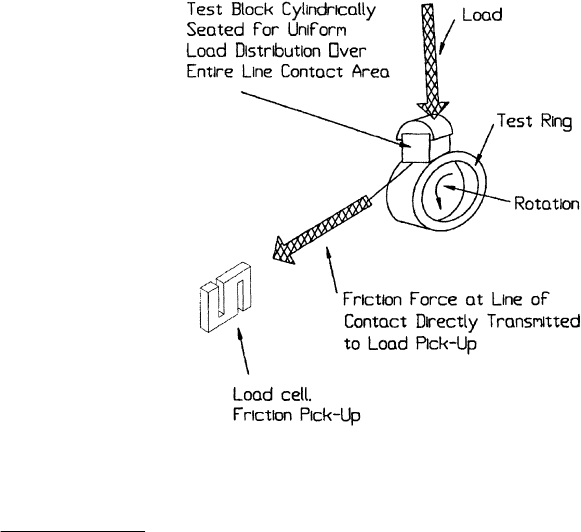
For example, curves can cross. In such a case, the relative rankings of the materials
change, depending on the region the ranking is done (e.g., before or after the intersection).
Another example is when one material shows a decreasing wear rate, while another shows
an increasing wear rate. This implies that an intersection is likely at some point, even if
it did not occur in the test. In cases like these, direct application of the results to a situation
is risky. In general, such results indicate that further study or additional information
is needed before the results can be applied. Frequently, this can be done by extending the
test long enough so that the overall behavior can be broken up into a short- and long-term
region, each being characterized by a particular level or amount of wear and morphology.
The concept is that these two regions can be related to initial and long range wear in
an application.
In effect, the ASTM standard for the cavitation test does that in terms of the guide-
lines for test duration, that is, test until the maximum erosion rate is achieved (long-term
behavior) or test to common wear depth. The magnitude of the wear depth that is used
would depend on the application that is being considered. These concepts are illustrated
in Fig. 9.19. In general, when the use of a graphic comparison is needed because of the
varied nature of the materials wear behavior, more extensive testing and careful consi-
deration of the application are required. An alternate approach is to use another test to
simulate the application, one in which the ambiguity does not occur.
9.2.6. Block-on-Ring Wear Test Using Wear Volume
ThebasicconfigurationofthistestisshowninFig.9.20. It is one of the more commonly
used test configurations to study sliding wear and to rank materials in terms of resistance
Another test method using this general configuration and wear rate is discussed in Sec. 9.2.16.
Figure 9.20 Schematic of a block-on-ring sliding wear test. Transducer to measure friction is not
always part of apparatus.
Copyright 2004 by Marcel Dekker, Inc. All Rights Reserved.

to sliding wear. While both the block and ring can wear in this test, the test is primarily
used to evaluate the wear of the block material. This same test configuration has been used
to evaluate lubricants (22). The methods of conducting the test, the data obtained, and the
methods of analysis used are different for lubricant evaluations and wear studies. How-
ever, many of the aspects associated with control are the same. The test itself can be con-
ducted under a variety of conditions of load, speed, lubrication, and even environments.
When this test is used to rank materials, the ring material is typically fixed and the block
material is varied. However, the wear of the block, which tends to experience the most pro-
nounced wear in the test, can be influenced by the material of the ring. As a consequence,
when used to rank individual materials for an intended application, the ring material
should be one of the materials used in the application. If not, the correlation between test
rankings and field performance is likely to be poor. Also, in relating wear behavior in the
test to wear be havior in an application, it is necessary to consider the wear on the block
and the ring, not just the wear on the block. When this is done and the test conditions
provide good simulation of an application, material rankings obtained with this test have
been found to correlate with field experience (23).
An ASTM standard for wear testing using this type of test has been developed
(ASTM G77).
These provide guidelines for conducting the test and analyzing an d
reporting data. Interlaboratory test programs using the procedures of ASTM G77 have
indicated that the intralaboratory coefficient of variation for the block wear volumes is
typically 20% for metals. The interlabora tory variations are larger, 30%. For some
materials and test conditions, coefficients in the range of 10% have been obtained.
The coefficient for ring volume tends to be significantly higher than those obtained
for the block (e.g., two times higher). The coefficients of variation can vary with mate-
rials and test parameters. For example, with some plastics and short test times intra
and interlaboratory coefficients of variations in the range between 30% and 60% have
been found. For 10 longer tests, these coefficients reduce to the order of 10%. The
variation associated with this test is partially the result of the sensitivity of this type
of wear to a large number of parameters. It is also the result of measurement accuracy.
The coefficient of variation for the wid th of the wear scar on the block, which is
directly measured in the test and used to compute the volume, is significantly less
(e.g., they are in the range 5–20%). However, for the geometries of the test, wear
volume is related to the square of the width, which results in larger coefficients for this
measure. For the ring, wear volume is determined by measuring a small change in a
large mass. Because of the large variation associated with wear volumes in this test,
it is generally recommended that several replicates (e.g., three or four tests) be done
when using it to rank material pairs.
The basic test method is to press the block against the rotating ring and the wear on
both the block and ring is measured after a specified number of revolutions. On the block,
a cylindrical groove is generated as a result of the wear. The volume of the wear is deter-
mined by first measuring the width of the groove and to use this to calculate the volume.
ThegeometricalrelationshipandtheequationareshowninFig.9.21
. The volume of wear
for the ring is determined by mass loss and converted to volume loss by means of the
density of the ring. While the standard test method does not specify a load or test dura-
tion, it does require a single load and number of revolut ions be used when evaluating
ASTM G176 is a specific version of this method for plastic.
Copyright 2004 by Marcel Dekker, Inc. All Rights Reserved.
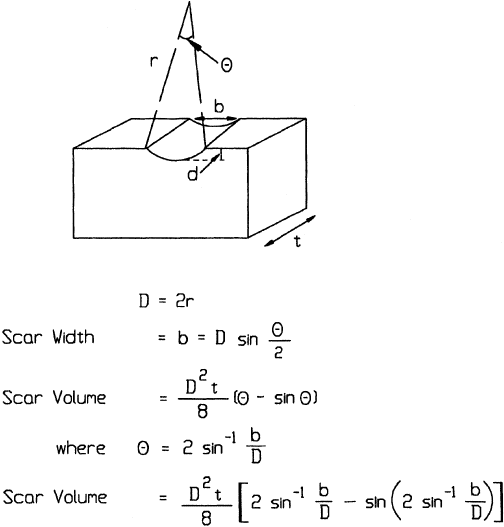
materials. The number of revolutions and load used is to be reported with the wear volume
measurements. The wear volumes are then used to rank materials in terms of their
wear resistance. In addition, the standard test method requires friction measurements
at the beginning, during and at the end of the test.
Elements of control are a significant portion of the standard test method. Principal
areas of concern are apparatus construction and design and specimen geometry and pre-
paration. Like the dry and wet sand tests, the overall construction of the apparatus can
influence the results, through such aspects as dynamic characteristics, stiffness, ability to
maintain alignment under dynamic conditions, to name a few. To control these factors,
specific dimensions and tolerances are specified for critical elements, such as concentricity
of the ring, specimen geometry, and bearings. Beyond this, the standard also specifies
that a standard test be run to qualify a particular apparatus. This standard qualification
test is found in ASTM’s D2714.
Since the test can be performed with a wide variety of materials with different surface
conditions, specific details regarding specim en preparation and cleaning are not provided.
It is pointed out that this mode of wear can be very sensitive to the presence of surface
contamination, surface composition, roughness, and oxide layers, and therefore these
elements need to be controlled. It is pointed out that characterization of surfaces by
suchtechniquesasscanningelectronmicroscopy(SEM)
and electron dispersive x-ray
(EDX) might be appropriate. If a lubricant is being used in the evaluations, appropriate
control of the lubricant and method of lubrication is also needed.
The standard also prescribes specific procedures to be followed in the test as an
additional means of providing control. For example, instructions as to how to handle
Figure 9.21 Method for determining the block wear volume from a measurement of the width of
the wear scar. (From Ref. 118.)
Copyright 2004 by Marcel Dekker, Inc. All Rights Reserved.
